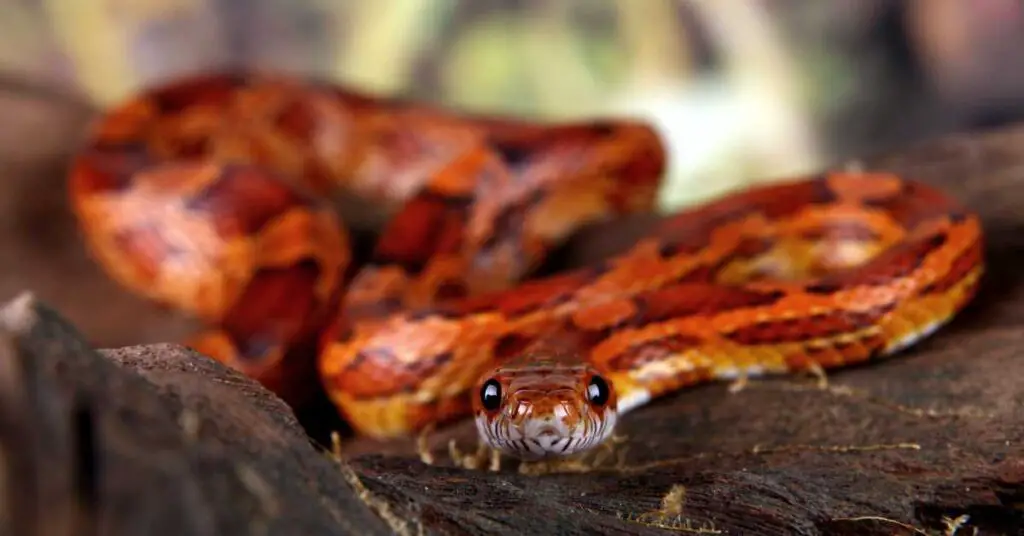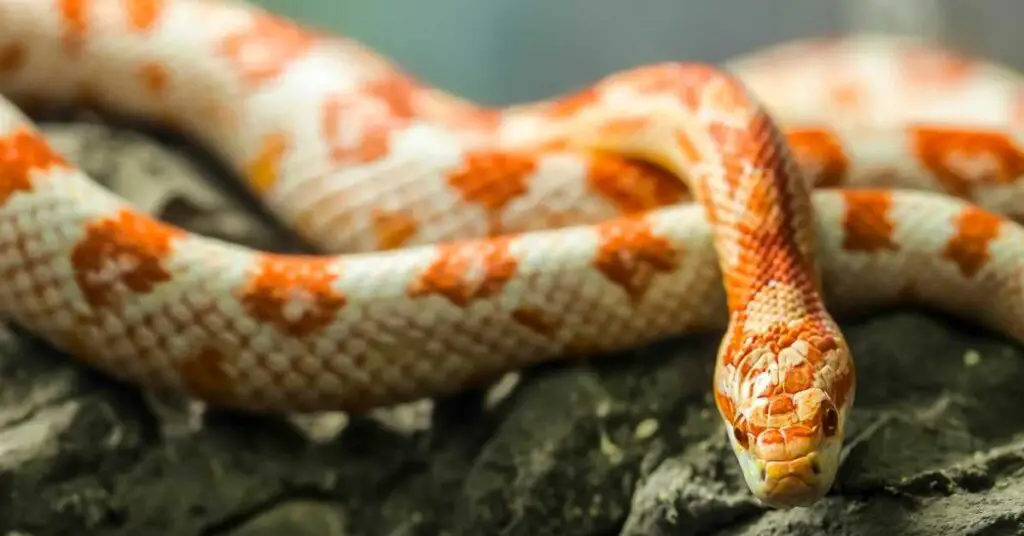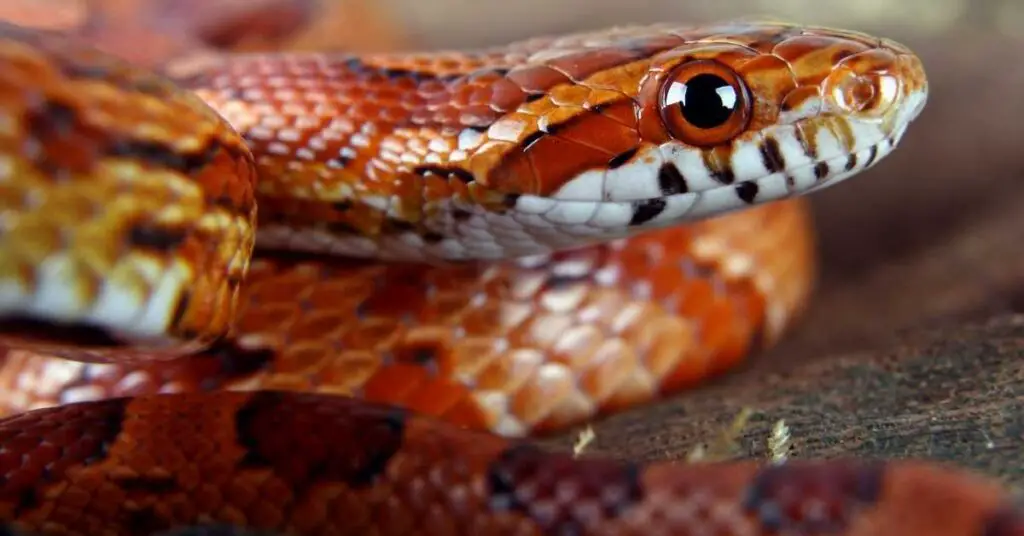Can corn snakes swim? Yes, corn snakes can swim. Although they don’t typically stay in the water for long, they can use their tail to propel themselves through the water if needed. Corn snakes are excellent climbers as well, so they may climb out of water when threatened or scared.
Corn snakes (Pantherophis guttatus) are a species of non-venomous colubrid snake native to North America. They are popular among reptile enthusiasts due to their attractive colors and docile nature. As such, understanding the behavior and ecology of this species is important for their successful maintenance in captivity.
One behavior that has not been studied extensively is swimming; this article will explore whether corn snakes can swim and if so, how they perform in the aquatic environment.
Can Corn Snakes Swim?
Yes, corn snakes can and will swim when they want to. This can be to hunt prey items in the wild or when they want to take a soak in their water bowl when it is time to shed. Even though they can swim and seem to like it fine, corn snakes are not considered a “water snake” like some wild specimens like a blotched water snake or a broad-banded water snake.

Anatomy Of The Corn Snake
The corn snake is an intriguing, non-venomous snake that has captivated the interest of the public for centuries. Despite its seemingly innocuous nature, it is characterized by several remarkable features.
Its scales provide a durable armor, shedding occurs periodically during its lifetime, and locomotion on land is achieved with remarkable speed and agility.
The corn snake is also known to enter periods of hibernation during winter months, which allows it to survive in temperate climates.
Interestingly, despite being a terrestrial species most active on land, this small reptile has occasionally been observed in watery habitats such as marshes and swamps.
Therefore, while the corn snake cannot swim in a conventional sense as other aquatic animals do, it can still traverse watery environments with ease and dexterity.
Corn Snake Habitat
Corn snakes are terrestrial animals, meaning they primarily live on land. They typically inhabit areas such as fields, meadows, forests, and barns.
In the wild, their hibernation habits are triggered by weather changes and generally occur from October to March in order to survive colder temperatures.
Natural predators of corn snakes include hawks, owls, and other larger reptiles.
When kept in captivity, corn snakes can thrive in a 20-gallon tank or larger with a secure screen top that is well-ventilated. A substrate such as aspen shavings should be used to create their desired environment and facilitate natural behaviors like burrowing and hiding.
Tank requirements also include appropriate temperature ranges between 75–85 °F (24–29 °C) and a humidity level of 50-60% which can be maintained using a water bowl or misting system.
The shedding frequency of corn snakes depends on growth rate but they typically shed 2-4 times per year.
Appropriate environmental needs must be met for them to remain healthy; this includes providing 12 hours of light per day along with a basking spot and hides for security.
Corn Snake Behaviors
Corn snakes are a type of colubrid snake found across the southeastern United States. They are popular as pets due to their docile nature and ease of care. Understanding corn snake behavior is critical in providing proper care for them.
Socializing corn snakes is important to ensure they do not become too shy or skittish when being handled. Corn snakes may be reluctant to be held because they are nocturnal and prefer to hunt at night.
Offering food treats such as small mice can help make handling more pleasant for both the snake and its handler.
Breeding corn snakes should only be attempted by experienced keepers, as it requires special knowledge and equipment. In addition, morphs of corn snakes have been bred in captivity, creating a variety of different colors and patterns for collectors to choose from.
Bathing corn snakes is also important for their health and wellbeing; it helps cleanse the skin of dirt, debris, and parasites that could cause health problems if left untreated.
A shallow bowl of lukewarm water placed in the enclosure should suffice for most needs; however, an occasional soak outside of the enclosure may be beneficial if done properly.
Caring for corn snakes does not require much work beyond providing a suitable habitat with the appropriate temperature, humidity, lighting, and substrate; however, understanding their behaviors will improve the overall quality of life for these interesting reptiles.

Corn Snake Diet
The diet of a corn snake is an integral part of its natural behavior, and must be taken into account when considering its needs.
When it comes to their foraging habits, corn snakes are voracious predators; they will eat any creature they can overpower, with mice being their food of choice.
Appropriate environmental needs must be provided in the enclosure to ensure that the snake remains healthy and active.
This includes providing a well-ventilated space with appropriate temperature regulation to match the species’ native habitat.
Additionally, the enclosure should be big enough for the snake to move around comfortably and have places for it to hide during the shedding process.
Furthermore, essential items such as water dishes and hiding places should also be included in the setup.
It is clear then that providing a suitable environment for your corn snake is absolutely essential in order for it to thrive.
Corn Snake Lifespan
Corn snakes, also known as red rat snakes, are relatively small and non-venomous constrictors with a lifespan of up to 20 years when kept in captivity. They are native to the southeastern United States and prefer habitats such as forests, fields, and farms.
As well as being terrestrial, corn snakes are excellent climbers and can swim; however, they do not like to spend extended periods of time in the water. Breeding habits vary depending on the region of origin but typically occur in the spring or summer months.
Captive requirements include an enclosure that is at least 36 inches long with a secure lid, a temperature gradient between 75F-80F and 55F-60F for nighttime temperatures, UVB lighting 12 hours per day, a large water bowl for drinking and bathing which should be changed regularly, soft substrate for burrowing, hiding spots such as logs or rocks and a variety of live feeders like mice or rats.
Corn snakes usually shed every four weeks and their color variations range from yellow to grey with blotched reddish-brown patterning along the length of their body. To regulate temperature they often bask in the sun but will retreat into hiding spots if too warm.
Safety Guidelines For Handling Corn Snakes
Corn snakes are one of the most popular species of pet snakes in the United States, with an estimated 1.5 million households owning them.
As such, it is important for prospective owners to understand the safety guidelines for handling these creatures and providing them with a healthy environment.
Housing requirements for corn snakes should include an enclosure that is large enough for the snake to move and explore, as well as cage enrichment items such as hiding spots and climbing branches to stimulate their natural behavior.
Temperature regulation is also important; the enclosure should be kept between 75-80 Fahrenheit during daytime hours, and slightly cooler at night.
Additionally, it is critical that corn snakes have access to a shedding box filled with moistened substrate or paper towels so they can complete the shedding process properly.
Lastly, environmental enrichment activities such as providing objects like scents or toys can help keep your pet happy and healthy.
Understanding these safety guidelines will provide a safe home environment for your corn snake and ensure its overall health and well-being.
Frequently Asked Questions
How Fast Can A Corn Snake Swim?
The speed at which a corn snake swims is largely determined by several factors. These include water temperature, enclosure size, swimming style and the use of any swimming aids.
Generally speaking, corn snakes are not strong swimmers and can typically reach speeds of 1-2 meters per second in optimal conditions. However, if the water temperature is too cold or if the enclosure size is large enough to require a swim of a substantial distance, the snake’s speed may be significantly reduced.
Additionally, some species of corn snake may have more developed swimming abilities than others due to their body structure and natural ability to move through water.
How Deep Of Water Can A Corn Snake Tolerate?
Corn snakes are not natural swimmers, but with the right safety precautions and swimming aids, they can tolerate short-term submergence in shallow water.
Water temperatures should be kept at a comfortable level for the snake and should not exceed 85 degrees Fahrenheit.
During times when a corn snake is submerged in water, it is important to monitor its behavioral cues.
If the snake appears distressed or unable to swim properly, it is best to remove it from the water immediately.
It is also important to note that corn snakes do not get their hydration from swimming; they still need to drink water regularly in order to stay hydrated.
Can A Corn Snake Be Kept In An Outdoor Environment?
Corn snakes can potentially thrive in an outdoor environment, provided their habitat requirements are met. When designing the enclosure, it is important to keep in mind temperature considerations, hydration needs, and food sources.
An outdoor enclosure should be properly insulated with shade cloth or a mesh cover to keep the heat inside. The temperature must remain between 75-85°F during the day and 65-75°F at night.
Access to fresh water is essential for hydration and the substrate should be kept moist but not wet. Food sources such as small rodents, lizards, frogs, and insects may be available naturally in the outdoor area or given by the owner.

How Can I Encourage My Corn Snake To Swim?
Corn snakes are not natural swimmers and will generally prefer to avoid water, however with proper supervision and safety precautions they can be taught to swim.
Encouraging play in warm water may help the snake become comfortable enough to explore options in the pool or pond.
It is important to make sure the water remains at a comfortable temperature for the snake as well as provide enough support and security for it.
Does Swimming Have Any Health Benefits For A Corn Snake?
Swimming can provide a range of health benefits to corn snakes, particularly when the environment is safe and secure.
For example, prolonged exposure to water temperature that is similar to their natural environment may help reduce stress levels for corn snakes.
Additionally, exposure to aquatic plants and clean water quality in an aquarium or just keeping a bowl deep enough for your corn snake to soak in their enclosure may offer additional benefits.
Ultimately, swimming can be beneficial for corn snakes from both a physical and mental perspective if the conditions are suitable.
Conclusion
Corn snakes are a unique species that can swim if given the chance. It is important to note that they should not be kept in an outdoor environment as they are sensitive to temperature changes.
Swimming allows for corn snakes to exercise and strengthen their muscles, thus providing potential health benefits. However, it is essential to pay attention to the depth of water and speed at which a corn snake swims, as these factors can affect its well-being.
We must remember that corn snakes are living creatures with specific needs; by understanding them better and providing appropriate environments, we can ensure their safety and comfort. Therefore, let us take time to appreciate their uniqueness and provide them with the best care possible.
Metaphorically speaking, we must be willing to “dive deeper” into loving our beloved corn snake companions.

